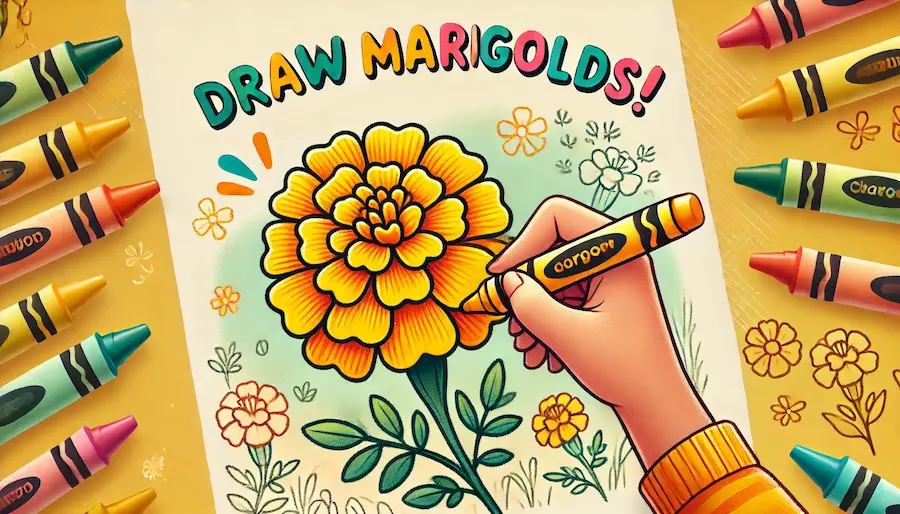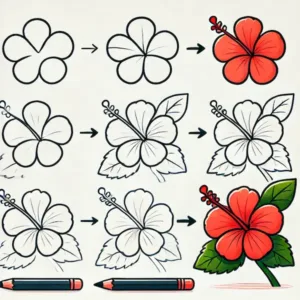Marigolds are delightful blooms celebrated for their vibrant, sunny hues and unique, frilly petals. Often linked to playful settings and joyful occasions, these blooms provide a wonderful opportunity for young ones to explore their artistic skills. This guide will take you on a delightful journey through the easy steps to create a lovely marigold drawing. Whether for a school project or an enjoyable art activity, young ones will love diving into their imagination while learning to draw this colorful flower.
Materials Used
To begin your creative journey, collect these essential supplies:
Any kind of paper suitable for drawing or sketching.
A regular HB pencil for drawing the initial outline.
Tool for fixing errors and perfecting your artwork.
Vibrant hues such as sunny yellow, cheerful orange, and lively green to make the marigold bloom with energy.
Black Marker (optional): To outline and bring out the final drawing for a neat and finished look.
Themes for Marigold Drawing
Young ones can delve into different themes while sketching marigolds, igniting their imagination:
Marigold Garden: Create a vibrant scene of a garden bursting with marigolds in various hues and dimensions, highlighting their charm in a serene environment.
Marigold Bouquet: Assemble a lovely arrangement of marigolds, neatly bound with a ribbon, ideal for sharing or enhancing your space.
Colorful marigolds surrounded by butterflies or bees, showcasing the beautiful connection between blooming flowers and the lively creatures that visit them.
Seasonal Marigolds: Discover the vibrant transformations of marigolds throughout the year, from their cheerful blooms in spring to their enchanting presence amidst autumn foliage.
Step-by-Step Instructions on How to Draw a Marigold for Kids
Discover these simple steps to craft a beautiful marigold drawing!

Step 1: Create the Heart of the Flower
Begin by creating a tiny circle right in the middle of your paper. This circle will symbolize the heart of the marigold, with the petals gently embracing it all around.

Step 2: Incorporate the Inner Petals
Draw gentle, rounded forms around the circle that will represent the inner petals. The petals of marigolds often have a gentle wave and can be arranged in layers. Sketch around 5-6 petals that are near the central circle, giving each one a slightly different shape for a more organic appearance.

Step 3: Create the Outer Petals
Now, sketch the outer petals that bloom from the inner ones. These could be bigger and might take on a more stretched or oval form. Try to create 10-15 outer petals, ensuring they slightly overlap to achieve a more abundant look. The petals of the marigold usually feature a delightful ruffled edge, so be sure to add some gentle curves.

Step 4: Craft the Foundation
Under the flower, create a bold line that stretches downwards to symbolize the stem. Marigold stems are usually strong, so ensure the line is tight and secure.

Step 5: Include Foliage
On either side of the stem, sketch the leaves of the marigold plant. These leaves often have a bumpy edge or sharp points, ending in a little pointy tip. Feel free to create a few leaves, playing with their sizes and angles to give a lively and organic appearance.

Step 6: Add intricate details to the petals
To make the petals look even more beautiful, you can create some texture by sketching delicate lines along their edges and in the centers. This detail will help to illustrate the textured and multi-dimensional appearance of marigold petals.

Step 7: Bring Your Marigold to Life with Color
Now it’s time to bring in some vibrant hues! Marigolds shine with bright yellows and oranges, making these colors perfect for the petals. Mixing various tones can add richness, placing deeper hues at the core and softer ones at the edges. For the foliage, choose a deep green, incorporating brighter tones for accents.
Step 8: Include Additional Background Features (Optional)
Think about adding some background details to enhance the liveliness of your drawing. Imagine adding a bright blue sky, colorful blooms, or even a charming little fence to make a delightful setting for your marigold.
Take Inspiration
Here are some ideas to spark creativity for young artists working on their marigold drawings:
Flower Gardens: Exploring a nearby garden or botanical park can spark imagination with vibrant marigolds all around.
Explore delightful art books designed for young readers that showcase the beauty of flowers and nature, offering inspiration for various drawing techniques and styles.
Exploring pictures of marigolds can enhance your understanding of their unique shapes and vibrant colors.
Craft Projects: Discover fun activities that include marigold flowers, like making paper flowers, which can help appreciate their shape.

FAQs: How to Draw a Marigold
Can drawing a marigold be a challenge?
Creating marigolds can be enjoyable and easy to do! By simplifying the process into manageable parts, young ones can effortlessly recreate the flower’s form and design without experiencing any stress.
Which colors would be best for my marigold drawing?
Marigolds often shine in cheerful shades of yellow and orange, but they can also surprise you with hints of red and brown. Young ones can explore a variety of colors, infusing their creations with their unique flair.
What are some ways to enhance the realism of my marigold drawing?
Incorporating shading and intricate details is essential for achieving a lifelike appearance. Apply deeper hues in the centers of the petals, gradually transitioning to softer tones at the edges. Incorporating texture lines will beautifully elevate the flower’s look.
Is it possible to combine marigolds with different types of flowers in my drawings?
Absolutely! Marigolds create a lovely display when paired with other blooms like zinnias or daisies. Mixing various kinds of flowers can result in a lively and captivating arrangement.
What if my drawing doesn’t look the way I imagined?
Inspire young minds to explore their imagination! Art allows for personal expression, and each creation is one-of-a-kind. Errors can spark fresh concepts and surprising charm in their creations.
Case Study: Marigold Drawing Class
At a nearby community art center, a delightful art class was arranged for young ones aged 6-11, centered around the enchanting task of drawing marigolds. The session began with a delightful chat about the importance and features of marigolds, leading into a fun drawing activity.
Result:
The little ones found joy in the activity of illustrating marigolds, particularly relishing the focus on vibrant hues and forms.
Skill Development: The class fostered a keen sense of observation and inspired a focus on intricate details such as texture and layering.
Imaginative Exploration: Every young artist crafted a distinctive artwork, blending their preferred hues and infusing personal touches such as bugs or various blossoms.
Conclusion
Creating marigolds can be a delightful and imaginative adventure for young ones. The vibrant hues and unique forms of marigolds provide a wonderful chance for little creators to delve into their imaginative talents. This easy-to-follow guide offers a fun approach for young ones to discover the art of drawing these lovely flowers. So collect your supplies, unleash your creativity, and have fun exploring the world of drawing marigolds!





